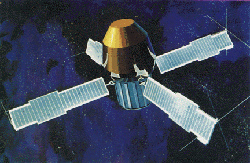Small Astronomy Satellite Series
Small Astronomy Satellite Series

An artist's impresion of the SAS-2 satellite. (Credit: NASA)

Marjorie Townsent discusses the SAS-1's performance with Bruno Rossi during reflight tests at NASA's Goddard Space Flight Center. (Credit: NASA)
The Small Astornomy Satellite series were a series of satellites aimed at studying the X-ray, gamma-ray, ultraviolet, visible, and infrared regions of the electromagnetic spectrum. SAS-1 was NASA's first dedicated X-ray astronomy satellite and was renamed Uhuru. SAS-2 was a gamma-ray telescope. SAS-3 was an X-ray astronomy space telescope.
Lifetime: December 1970 (launch of SAS-1/Uhuru) - April 1979 (SAS-3 ceases operations)
Country (primary): United States
Primary Science
The SAS series of satellites were dedicated to exploring the high-energy sky from ultraviolet (SAS-4) up through X-ray (SAS-1 and SAS-2) and gamma-ray (SAS-2).
Uhuru/SAS-1
Lifetime: December 1970 - March 1973 (last contact)
Science Highlights
- First comprehensive and universe all-sky survey in the X-ray with a limiting sensitivity of 1.4 × 10-11 ergs/sec2/s.
- Detected 339 sources, includeing binaries, supernova remnants, active galactic nuclei and clusters of galaxies
- Discovered diffuse X-ray emission from clusters of galaxies
Links to more information
SAS-2
Lifetime: November 1972 - June 1973 (last data collected)
Science Highlights
- First detailed look at the gamma-ray siky
- Established the high-energy component of the diffuse celestial radiation background
- Correlated the gamma-ray background with galactic structural features
Links to more information
SAS-3
Lifetime: May 1975 - April 1979
Science Highlights
- First observations in the X-ray that were localized precisely enough for follow-up observations by optical telescopes
- Established the identification of bursting X-ray sources with neutron star binary systems
- Discovery of the first quasar loacted through its X-ray emission

